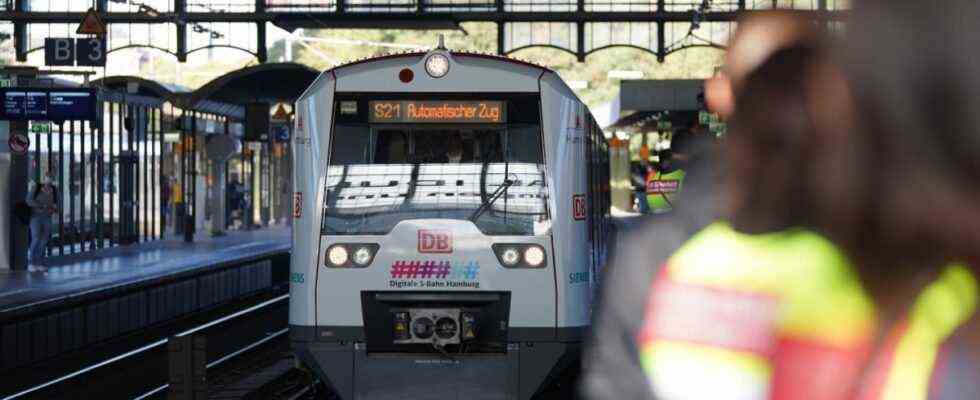Passengers on the platform can hardly tell that a vision is rolling off the Dammtor train station in Hamburg that morning. The type 474 railcar looks more like a commuter scare than a revolution. Only the train indicators on the track make it clear that there will be no normal S-Bahn line 21 on Monday, but a “world premiere”.
Accelerated by a machine, controlled by algorithms, braked by computer chips. The S-Bahn to Bergedorf is part of the most important pilot project for automatic train traffic in Germany. Deutsche Bahn and Siemens have digitally upgraded several trains in Hamburg’s S-Bahn so that they can travel automatically. On Monday, the first rolled over the 23-kilometer test route to the suburbs of the Hanseatic city with passengers on board. With the timetable change on December 12th, the trains will start regular passenger service.
The digital S-Bahn represent a gigantic project. The first thing the group wants to do in a few years is to convert the S-Bahn in the Hanseatic city to digital operation, and then to switch to large parts of all rail traffic in Germany over the next 15 to 20 years. According to McKinsey consultants, the move to digitization of the rail network will cost around 35 billion euros in the next few years. It’s about one of the largest infrastructure projects in the country.
In the prototype cockpit, it becomes clear what is changing. If the train drivers switch to automatic train operation at the push of a button, they can put their hands on their laps. The trains accelerate and brake automatically. They calculate the stopping time at the stations, and open and close the doors. Nevertheless, it does not work entirely without a train driver. Because if something unforeseeable happens, for example when people walk on the track, the human staff has to take over immediately.
Soon it could be possible without a train driver
On Monday, train driver Valeska Hoop sits in the cockpit. The technology is a relief. She is not afraid of her job or that of her 20,000 colleagues in Germany, says Hoop. It is still not possible without her. The trains in the project are supplied with electronic information about the route and other trains, but have no sensors to detect objects on the route, for example. Experts, however, definitely see the possibility that this will change and that the trains will be able to operate in the cockpit by the end of the decade without staff being permanently present. According to the industry, the technology is constantly being further developed. Trade unions are also already worried about jobs, but did not want to officially comment on Monday.
Conflicts loom because Deutsche Bahn would like to digitize the entire network, i.e. long-distance, local and freight traffic, as quickly as possible. Mainly for one reason: the network is reaching its limits in many places. At rail hubs such as Mannheim, Cologne or Frankfurt there is simply no more traffic using conventional means. Digital upgrade could change that. Because authorities trust technology more than people do, the digitally controlled train is allowed to travel at closer intervals. Up to 30 percent more trains could be on the same network, says rail boss Richard Lutz: “Without even laying a new track.” The automatic system should also help save 30 percent energy and be 15 percent more punctual.
But apart from the prestige projects like in Hamburg, there is frustration in parts of the railway about the speed of digitization in their own group. The plans have been around for years. But implementation is only progressing slowly. According to its own information, the federal government began the planned nationwide introduction of the European train control system ETCS – the basis for automatic traffic – in 2015. She has not come very far in the past six years. According to current information, only 340 kilometers have been converted – that is, one percent of the network. Further pilot projects are planned, but this has not yet been a big hit.
Experts recently criticized the pace of the renovation. Heike van Hoorn, managing director of the German Transport Forum (DVF), made it clear what the slow pace means: “The digitization of the railways is the prerequisite for us to be able to achieve the goal of doubling the number of passengers and more goods by 2030 . ” And that should help to meet the German climate targets.
The technology is actually already in use. If you want to know what is technically feasible, you have to go underground: In 16 European cities from Copenhagen to Turin, subways and airport trains run completely automatically. In London, the underground will be converted over the next few years. And there are first examples in Germany as well: underground lines in Nuremberg have been running driverless for a number of years. The positive effect from the operator’s point of view: According to the city, the trains are almost 100 percent on time and consume less energy due to an optimized driving style.
Up until now, there have been no fully automatic trains operating above ground, where many more influences can disrupt the traffic. The technology presented by Bahn and Siemens on Monday is supposed to change that. Siemens boss Roland Busch described it as a “blueprint for the digitization of the railways in Germany, Europe and around the world”. It is also approved by the Federal Railway Authority for broader use.
Elsewhere in Europe, too, there are plans for automatic trains in the drawer. Deutsche Bahn has already agreed a joint digitization strategy with the French state railway SNCF. It stipulates that the Germans and the French will jointly develop the driverless train.

